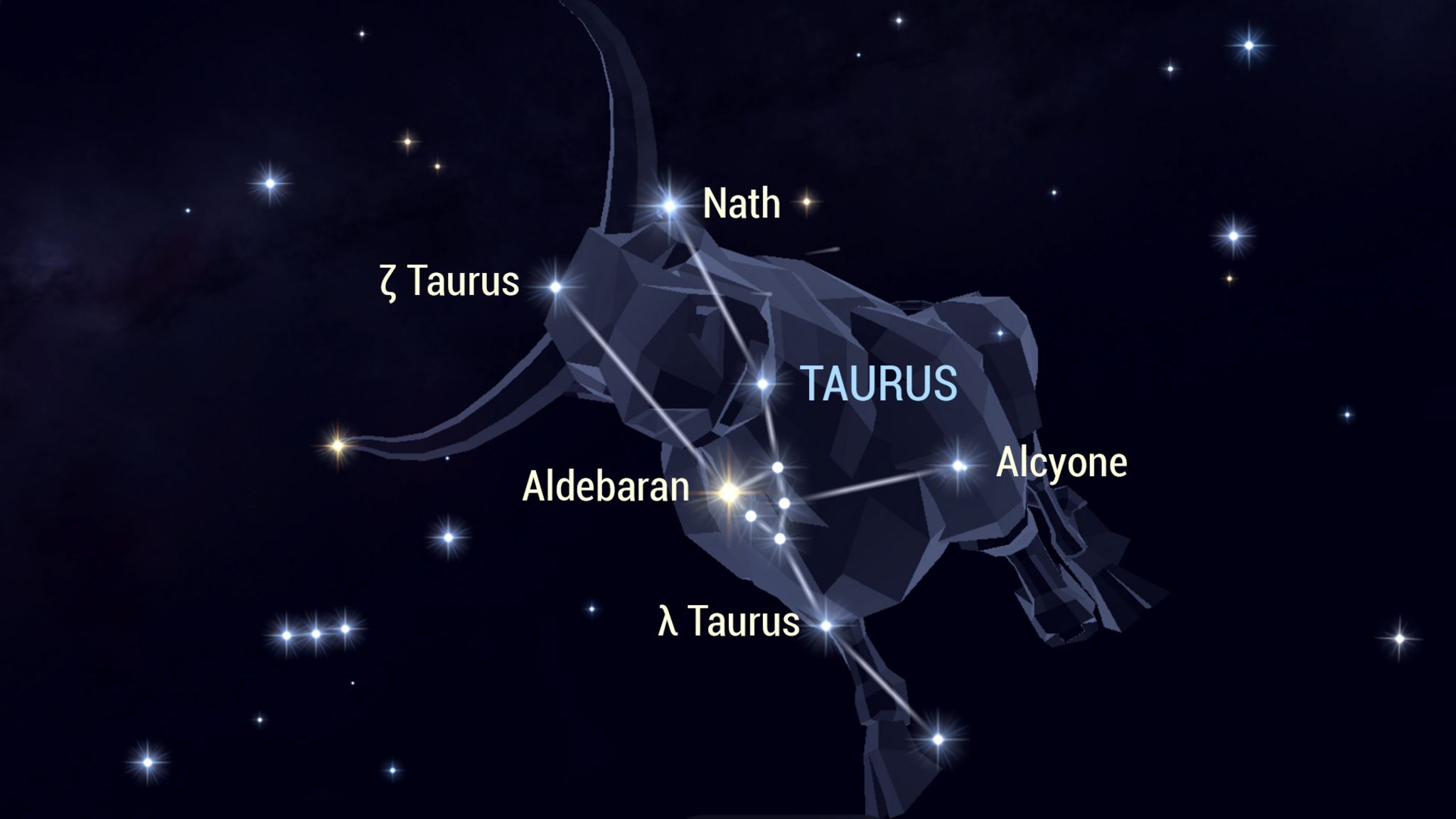Taurus in the Night Sky
Every year in early December, the distinctive constellation of Taurus (the Bull) returns to our evening skies, rising as darkness falls and crossing the sky through the night. It’s one of a handful of distinctive winter constellations that are easy to recognize with unaided eyes. It contains many wonderful objects to observe in small or large telescopes – from spectacular star clusters to a supernova remnant and more. Let’s talk about some of its treats you’ll spy during a winter stroll, and others that make setting up your telescope on a cold winter evening worth your while.
The constellation of Taurus is located on the ecliptic, just north of the celestial equator, making it visible almost globally. With the dim constellations of Cetus (the Whale), Pisces (the Fishes), and Aquarius (the Water-Bearer) lying just to the west of it (on the right), it makes quite an entrance as the late autumn nights lengthen. Taurus is the first in a parade of much brighter and better-known constellations such as Orion (the Hunter), Auriga (the Charioteer), and Gemini (the Twins). Being on Taurus’ eastern side, they rise later in the evening. To the north sits Perseus (the Hero) and below Taurus is the dim and winding constellation Eridanus (the River).
Taurus is dominated by several elements that combine to make the bull. A large triangular arrangement of stars form the bull’s face, with the bright reddish star Aldebaran sitting at the southeastern (lower left) vertex, marking his baleful eye. He’s literally seeing red! Two bright stars sitting 1.5 fist diameters to the lower left (east) mark the tips of his horns. Well above the face, the little Pleiades cluster marks his hunched shoulders - and to the east, a handful of less prominent stars form his chest and forelegs. The rest of him is missing. When he rises in the east, he is tilted sideways, horns down and legs extended - as if he’s charging the twins of Gemini. His doesn’t straighten up until after midnight when he enters the western half of the sky.
This week, Taurus rises at about 5 pm local time and climbs high into the southern sky around midnight, before descending westward to set around 7 am. To find the bull, continue the line formed by Orion’s belt westwards (upwards in early evening, or to the right later on) about two outstretched fist diameters (or 20°) until you reach bright Aldebaran. If Orion hasn’t risen yet, you can look high in the east for the little cluster of blue stars called the Pleiades. Taurus is about 12° below it.
Taurus’ triangular face is actually one of the nearest open star clusters to us. It’s only about 150 light years away. It’s called The Hyades, named for the five daughters of Atlas in Greek mythology. It actually contains several hundred stars, with a half-dozen or so readily seen under moonless suburban skies. It’s a lovely target to view in binoculars. By the way, Aldebaran is not part of the cluster. It is less than half as far away!
One of the most exciting objects in Taurus sits about one and a half fist widths above the bull’s face. It is the beautiful star cluster known as The Pleiades, or the Seven Sisters. It’s also designated Messier 45 (or M45), part of Charles Messier’s famous list of comet-like objects. The Pleiades is made up of the young, hot blue stars Asterope (“A-STER-oh-pee”), Merope, Electra, Maia, Taygeta, Celaeno, and Alcyone that are indeed related – born of the same primordial gas cloud. In Greek mythology, they were the daughters of Atlas, and half sisters of the Hyades. To the naked eye, only six of the sister stars are usually seen, with their parent stars Atlas and Plione huddled together at the east end of the grouping. Under magnification, hundreds of stars appear.
The Pleiades cluster is about 450 light years away, and makes a wonderful target in binoculars or a low magnification telescope, where many more siblings are revealed! A large telescope under dark skies will also reveal blue nebulosity around the stars – this is reflected light from unrelated gas that the stars are passing through. Galileo was among the first to observe the cluster in a telescope. In 1610, he published a sketch made at the eyepiece. Not surprisingly, many cultures, including Aztec, Maori, Sioux, Hindu, and more, have noted this object and developed stories around it. In Japan, it is called Suburu, and forms the logo of the eponymous car maker. Due to its shape and diminutive size, some people mistake the Pleiades for the Little Dipper.
The supernova remnant called the Crab Nebula (or Messier 1) sits a finger’s width above the bull’s lower horn star, Tianguan. You need a very large telescope to see the remnant as a dim, fuzzy patch - but on July 4, 1054 AD Chinese astronomers recorded that the star that exploded to create the Crab Nebula shone bright enough to see it in the daytime for three weeks! Then it faded to become the brightest night time star for a few months. The object is about 6,500 light-years from the sun.
One more treat - a very red, magnitude 4.3 star named The Ruby Star (or 119 Tauri) sits 2.7 finger widths to the right of Tianguan. It’s a variable star that pulsates every 165 days. There are even more sights to see in Taurus. And the outer rim of the Milky Way passes just beyond the horn tips, so this area will reward scanning with binoculars or telescope, too.
